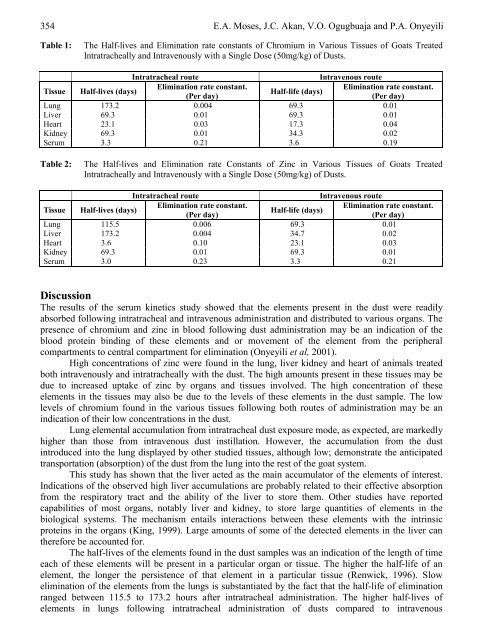European Journal of Scientific Research - EuroJournals
European Journal of Scientific Research - EuroJournals
European Journal of Scientific Research - EuroJournals
Create successful ePaper yourself
Turn your PDF publications into a flip-book with our unique Google optimized e-Paper software.
354 E.A. Moses, J.C. Akan, V.O. Ogugbuaja and P.A. Onyeyili<br />
Table 1: The Half-lives and Elimination rate constants <strong>of</strong> Chromium in Various Tissues <strong>of</strong> Goats Treated<br />
Intratracheally and Intravenously with a Single Dose (50mg/kg) <strong>of</strong> Dusts.<br />
Intratracheal route Intravenous route<br />
Tissue Half-lives (days)<br />
Elimination rate constant.<br />
(Per day)<br />
Half-life (days)<br />
Elimination rate constant.<br />
(Per day)<br />
Lung 173.2 0.004 69.3 0.01<br />
Liver 69.3 0.01 69.3 0.01<br />
Heart 23.1 0.03 17.3 0.04<br />
Kidney 69.3 0.01 34.3 0.02<br />
Serum 3.3 0.21 3.6 0.19<br />
Table 2: The Half-lives and Elimination rate Constants <strong>of</strong> Zinc in Various Tissues <strong>of</strong> Goats Treated<br />
Intratracheally and Intravenously with a Single Dose (50mg/kg) <strong>of</strong> Dusts.<br />
Intratracheal route Intravenous route<br />
Tissue Half-lives (days)<br />
Elimination rate constant.<br />
(Per day)<br />
Half-life (days)<br />
Elimination rate constant.<br />
(Per day)<br />
Lung 115.5 0.006 69.3 0.01<br />
Liver 173.2 0.004 34.7 0.02<br />
Heart 3.6 0.10 23.1 0.03<br />
Kidney 69.3 0.01 69.3 0.01<br />
Serum 3.0 0.23 3.3 0.21<br />
Discussion<br />
The results <strong>of</strong> the serum kinetics study showed that the elements present in the dust were readily<br />
absorbed following intratracheal and intravenous administration and distributed to various organs. The<br />
presence <strong>of</strong> chromium and zinc in blood following dust administration may be an indication <strong>of</strong> the<br />
blood protein binding <strong>of</strong> these elements and or movement <strong>of</strong> the element from the peripheral<br />
compartments to central compartment for elimination (Onyeyili et al, 2001).<br />
High concentrations <strong>of</strong> zinc were found in the lung, liver kidney and heart <strong>of</strong> animals treated<br />
both intravenously and intratracheally with the dust. The high amounts present in these tissues may be<br />
due to increased uptake <strong>of</strong> zinc by organs and tissues involved. The high concentration <strong>of</strong> these<br />
elements in the tissues may also be due to the levels <strong>of</strong> these elements in the dust sample. The low<br />
levels <strong>of</strong> chromium found in the various tissues following both routes <strong>of</strong> administration may be an<br />
indication <strong>of</strong> their low concentrations in the dust.<br />
Lung elemental accumulation from intratracheal dust exposure mode, as expected, are markedly<br />
higher than those from intravenous dust instillation. However, the accumulation from the dust<br />
introduced into the lung displayed by other studied tissues, although low; demonstrate the anticipated<br />
transportation (absorption) <strong>of</strong> the dust from the lung into the rest <strong>of</strong> the goat system.<br />
This study has shown that the liver acted as the main accumulator <strong>of</strong> the elements <strong>of</strong> interest.<br />
Indications <strong>of</strong> the observed high liver accumulations are probably related to their effective absorption<br />
from the respiratory tract and the ability <strong>of</strong> the liver to store them. Other studies have reported<br />
capabilities <strong>of</strong> most organs, notably liver and kidney, to store large quantities <strong>of</strong> elements in the<br />
biological systems. The mechanism entails interactions between these elements with the intrinsic<br />
proteins in the organs (King, 1999). Large amounts <strong>of</strong> some <strong>of</strong> the detected elements in the liver can<br />
therefore be accounted for.<br />
The half-lives <strong>of</strong> the elements found in the dust samples was an indication <strong>of</strong> the length <strong>of</strong> time<br />
each <strong>of</strong> these elements will be present in a particular organ or tissue. The higher the half-life <strong>of</strong> an<br />
element, the longer the persistence <strong>of</strong> that element in a particular tissue (Renwick, 1996). Slow<br />
elimination <strong>of</strong> the elements from the lungs is substantiated by the fact that the half-life <strong>of</strong> elimination<br />
ranged between 115.5 to 173.2 hours after intratracheal administration. The higher half-lives <strong>of</strong><br />
elements in lungs following intratracheal administration <strong>of</strong> dusts compared to intravenous

















